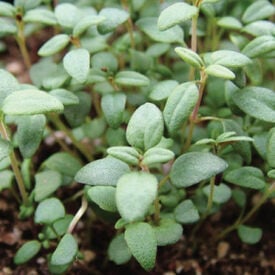Learn More
The Vulgaris Thyme, or also known as German Winter Thyme, is a Mediterranean herb with culinary, medicinal and ornamental uses. This thyme variety has larger leaves and is a great herb to add flavor to many fish, chicken and vegetable dishes. The Vulgaris plant produces well and is more frost hardy than other thyme varieties.
The English Thyme is a beautiful purple-gray flowering herb that brings out a great flavor when added to different dishes. This herb grows tall and wide and if allowed to flower, will bring butterflies and bees to the garden. English Thyme is commonly used for seasoning either fresh or dried.
The French Thyme is a popular herb used to add flavor in poultry and fishes dishes as well as salads, stews, sauces and pickles! This Thyme variety produces very aromatic blue-green leaves with pale lavender flowers that will add a pop of beautiful color to any garden or windowsill.
Wild Thyme has a wonder fragrance and beautiful bloom that does well in most gardens. Spreads easily on its own and does well in drought tolerant locations. Forms a dense mat that create an excellent ground-cover. Plants are 6-12 inches tall, and the lavender flowers appear just above the foliage. As with many species in the mint family, the flowers of Wild Thyme are very attractive to honey bees and wild bees. Also know as lemon thyme, larger thyme, and broad-leaf thyme.
Creeping thyme, also known as Thymus serpyllum, is a low-growing, aromatic herb with a long history of use in gardens and culinary applications. Native to Europe and Asia, creeping thyme has been valued since ancient times for its medicinal properties and culinary versatility. This perennial herb is characterized by its tiny, evergreen leaves and dense, mat-forming growth habit, which makes it an excellent choice for ground cover or between stepping stones in herb gardens. Creeping thyme typically features small, delicate pink or purple flowers that bloom in summer, adding a touch of color to its lush green foliage.The plants are known for their resilience and ability to thrive in well-drained soil and full sun to partial shade. With its pleasant fragrance, low-maintenance growth, and ability to attract pollinators, creeping thyme is a valuable addition to both ornamental and functional garden spaces.





